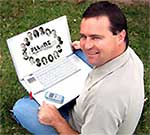The StudyTXT service is now not operational. We have decided to shut the service down and focus on other mobile delivery methods for learning. The StudyTXT project was an important landmark in the development of mLearning within New Zealand and this site is left up for information on the project. Peter Mellow. March 19, 2008
StudyTXT was a way to review key facts and concepts using the flexibility of your cellphone. Use the downtime you have in your day (waiting for a bus, on the train, sitting around campus, etc.) to view one StudyTXT message many times a day, until you know it and can apply it in your subject area.

StudyTXT was created in 2004 by Peter Mellow, Senior Lecturer at AUT. Peter has been working on the StudyTXT project since then, developing the concept and then setting up the working service for its first operational trials in October 2005. He is now expanding the service to other areas of education within New Zealand.
StudyTXT was made possible with the assistance of a RELT (Resources to Enhance Learning and Teaching) grant from AUT.
Research into mobile learning was assisted by FLLinNZ (Flexible Learning Leaders in NZ).
Below is one of the best lists of study hints I have ever found, and many are applicable to using StudyTXT messages. Mike was a great lecturer and friend who was sadly taken before his time. Thanks to his wife, Pam for letting us use his words here. He is still giving students advice!
Study Hints by Mike Guinan – Davis University CA USA
-Used with the express permission of Pam Pappone
1. Don’t just Memorize, Conceptualise
A bunch of details are hard to remember unless you can put them into some sort of conceptual framework. Don’t treat facts as isolated bits of information, but as parts of a bigger picture. For example, rather than just memorizing the location or function of the AV node, think about its role in electrically connecting the atria to the ventricles and how the Purkinje fibers found there distribute electrical activity to the apex of the heart.
2. Study early.
We try to sequence the lectures in a logical fashion so that earlier ones are giving you information helpful to understanding later ones. Your time spent in these later lectures will be more useful if you have reviewed and understood the earlier ones. Don’t leave it till the pre-exam weekend to make sense of it all.
3. Study briefly and often.
Especially true for memorization tasks. Try to go over items to be memorized many times with some time in between. That is, don’t spend an hour memorizing the differences between cardiac, smooth, and skeletal muscle; spend 5 minutes ,10 times over a week.
4. Use active, rather than passive, study techniques.
Looking at a figure from the syllabi or text is not nearly as valuable as sketching a crude figure yourself. Exact scale is not needed; you are usually just interested in the relation of one structure (bone, muscle artery, etc) to others. This way you also find out what you know and (more importantly) what you don’t know. Similarly, going over the labeled diagrams or images on the computer modules is not nearly as helpful as covering up the labels and naming things on a diagram or image. The computer modules are helpful, but remember, on the exam you may need to come up with the name of a structure rather than just pointing it out.
5. Try to identify structures by their important features.
There’s a tendency to memorize features on a particular image that may really have nothing to do with the actual structure involved. (e.g. the muscle cells are in the upper right corner.) You may be surprised at how much you are using these random kinds of features to identify particular structures. A good way to avoid this potential difficulty is to practice by trying identifying other tissues you see in lab slides.
6. Try to think about applications of your knowledge.
You may be asked some exam questions that require you reason with the information you’ve been given and come to a conclusion about a situation not specifically covered in lecture. For example, if you were asked to speculate on the possible functions of a unidentified group of cells in new animal that had lots of endoplasmic reticulum, abundant vesicles, and were arranged in invaginated tubes with ducts to the surface; you should be able to make some reasonable arguments for your ideas.
7. Take full advantage of the Lab time.
Since the labs are independent, self-paced activities and the web modules give another way to access much of the lab material, some students may be tempted to miss, or only briefly attend, the labs. I strongly encourage you spend the full time in the lab for several reasons. First, only looking at the web modules will give you a limited representation of the various structures we are studying (see 5 above). Some newer lab stations may not be on the modules yet. The lab will help you reinforce your understanding of the lecture material - don't view them as separate. Students who are having trouble in the course almost invariably are the ones who neglect the lab time. Don't be passive during lab -ask questions, move around on the slides, etc. Lab time is designed to give you the opportunity to interact with the instructors - take advantage of it.
8. Have a life (even if its just a few hours a week).
You could spend all your time studying and still probably not feel 100% ready for exams. Set aside some regular GUILT FREE time for yourself/family. You'll be happier and more efficient when you do study.
Hope these help.
|

